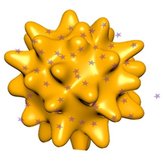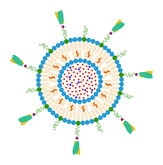Theme 1.1: Nanovectors and Nanoprobes
Some of our nanosystems
 |
 |
 |
 |
| Au NF-NB | SPION-PEG-scFv- siRNA-Cy5.5 |
SPION-PEG- miR |
Liposomes-scFv- Met-Dox |
| (Pacaud et al. 2019) | (Nguyen et al. 2021) | (Vilimova et al. 2022) | (Vozgirdaite et al. 2025) |
Objectives
- Target disease molecules, cells & tissues: improve specificity
- Drug delivery: reach therapeutic dose
- Efficiency: increase therapeutic effect
- Security: reduce secondary effects
- Diagnosis: explore new modalities, increase sensitivity
- Theranostics: diagnosis + therapy
Summary
This theme focuses on the development and characterization of various nanovectors (NVs) and nanoprobes (NPs) able to target pathologic biomarkers, cells and/or tissues in order to improve diagnostics, therapy or both (theranostics).
The NVs and NPs we work on can be divided into three families:
- Nanoprobes for diagnostics. Their objective is to detect biomarkers and aid in the diagnosis of certain diseases such as cancer, for example. The nanoprobes developed in this theme are based on gold, silver, iron oxide nanoparticles or their combination, with or without surface functionalization.
- Nanovectors for therapy. Their objective is to deliver one or more active ingredients into the cell to treat certain diseases such as cancer, for example. The nanovectors we develop include lipid nanovectors, such as liposomes or lipid nanocapsules (LNCs), most often surface functionalized to improve their biodistribution, cellular targeting and active ingredient delivery.
- Theranostic nanoparticles. These nanoparticles aim to combine therapy and diagnosis by means of imaging (fluorescence, MRI, nuclear imaging). They have typically a core-shell hybrid structure composed of superparamagnetic iron oxide nanoparticles (SPIONs), coated with polyethylene-glycol (PEG) to improve their stability and increase their half-life after intravenous injection. They are covalently labelled with NIR fluorophores for optical dtection and are functionalized with tageting ligands to improve their biodistribution. Finally, they are formulated for stimuli-dependent delivery of active ingredients (nucleic acids and/or chemotherapy).
Keywords
- Inorganic nanocore (iron oxides, gold, silver)
- Polymeric shell (PEG, Pluronics)
- Lipid nanovectors (liposomes, lipid nanocapsules)
- Targeting ligands (CPP, scFv)
- Surface functionalization (polymers, fluorophores, ligands)
- Nucleic acids (siRNA, miRNA)
- Anticancer agents (doxorubicin, mitoxatrone, paclitaxel)
- Theranostics (multimodal imaging, multimodal stimuli-responsive therapeutic action)